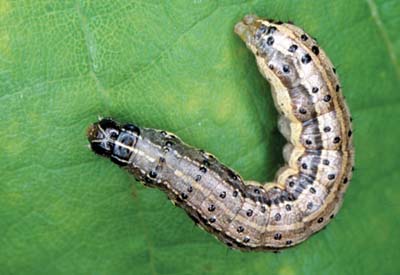Fall Armyworm, Spodoptera frugiperda
(Lepidoptera: Noctuidae)
The fall armyworm is distributed throughout the southern United States. This species is not able to diapause and overwinters successfully only in Florida and Texas. It is a strong flier and disperses long distances annually during the summer months. It is a regular and serious pest in the southeastern states. The life cycle is completed in 30 days during the summer, 60 days in the spring, and 80 to 90 days during the winter. The number of generations that occur in an area varies with the appearance of dispersing adults. The egg is dome-shaped and white. The female deposits a layer of grayish scales between the eggs and over the egg mass. These scales will give the egg mass a furry or moldy appearance. The larva is greenish with a black head, and eventually become brownish with lateral white lines. The head of the mature larva is marked with a white inverted “Y”. Pupation normally takes place in the soil in a loose cocoon. The pupal stage cannot stand prolonged periods of cold weather. The adult has a forewing that is shaded gray and brown with triangular white spots at the tip and near the center of the wing. The hind wing is silver white in color with a dark narrow border. Adults are nocturnal and are most active during warm humid evenings.
The fall armyworm has a wide host range of over 80 plants but clearly prefers grasses. The main vegetable crop attacked is corn. The larvae cause damage by consuming foliage. Young larvae cause a netted appearance of the leaf foliage; older larvae consume the entire leaf. Feeding in the whorl of corn will produce a characteristic row of perforations in the leaves.
Images
To save the Web-optimized images shown below to your hard drive:
PC users: right click to "Save Picture (or Image) As..."
Mac users: click and drag to your desktop.
Copyright © 2005 University of Florida
